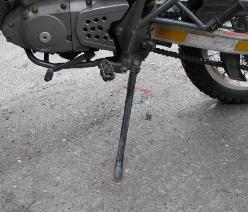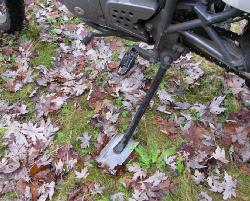Your first bike
There's some discussion on the bike forums about how big a bike to get; some people advocate getting a large bike if that's how you mean to continue. I don't; it will be heavier and will do more damage to itself, you, and other objects when you drop it. But you need a "real motorcycle" (with gears) that can keep up with traffic, not a toy or moped with a centrifugal clutch. Some jurisdictions may limit the engine size for a beginner, e.g. to 250cc. I'd suggest somewhere between 125cc-250cc, perhaps a used one if you want to trade up when you get a full licence.If you can't ride a bicycle, put the motorcycle away and get an old bicycle to learn how to steer.
Lesson 1 - the kickstand
If you have a bicycle, you probably lean it against utility poles, stuff it into bicycle racks or drop it on the ground. If you do that with a motorcycle, you'll scrape the paint, put dents in the fuel tank, break the flasher lenses and have gasoline, oil and battery acid leaking out. You don't want that. Also, if it lands on you, you could be hurt or burned on the exhaust pipe.Motorcycles come with a center stand, a kickstand, or sometimes both. These are designed for use on firm, level ground. Like the cement floor in the showroom. Real life isn't always like that. A heavy bike may put a pressure of some hundred pounds/square inch on the stand - enough to sink into mud, grass or warm tarmac. (Tarmac is really a viscous liquid with rock chips in it - put enough pressure on it for long enough and it will flow). So make sure the surface where you park your bike is firm. If not, move it or place a metal pad underneath the stand to spread the load. It must also be level, or the bike must be in gear facing uphill (along a fall line). If it faces downhill and slips, the stand may fold up, dropping the bike on the ground.


Kickstands are easy to use - you just kick them out (all the way out and
forward) then lean the bike carefully on them. Don't let go of the bike
until you are sure the stand is taking the weight and the bike is stable.
Center stands are trickier, especially with a large bike. Pull the stand
down with your foot till it hits the ground, then stand firmly on
the tab while pulling the bike backwards with the handlebars. Hold the
clutch in while you do this. The bike should
rock back on the stand, coming to rest with the front wheel slightly off
the ground. Let the clutch in. If parking on a slope, point the bike uphill and leave it in gear, as for the kickstand.